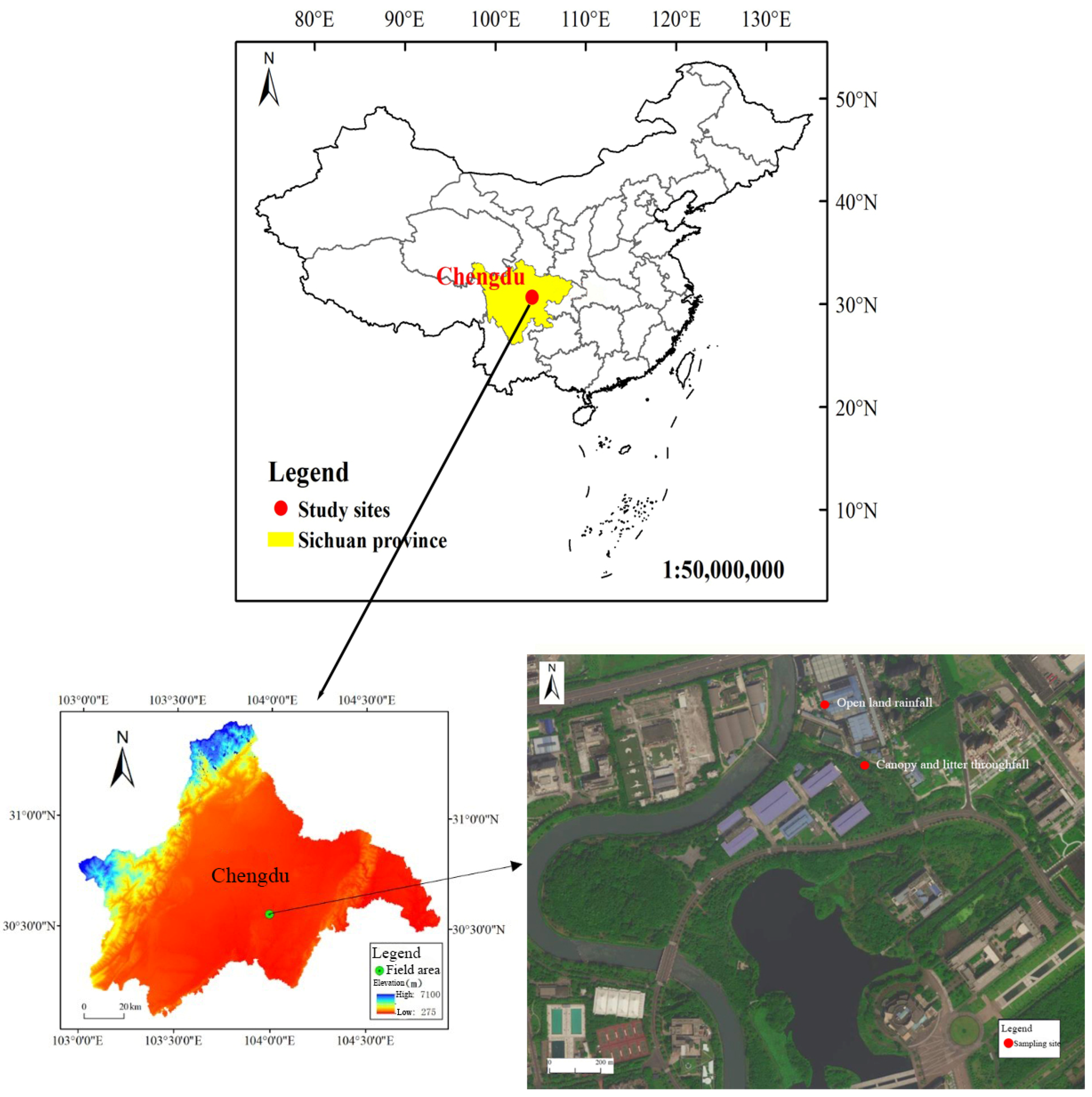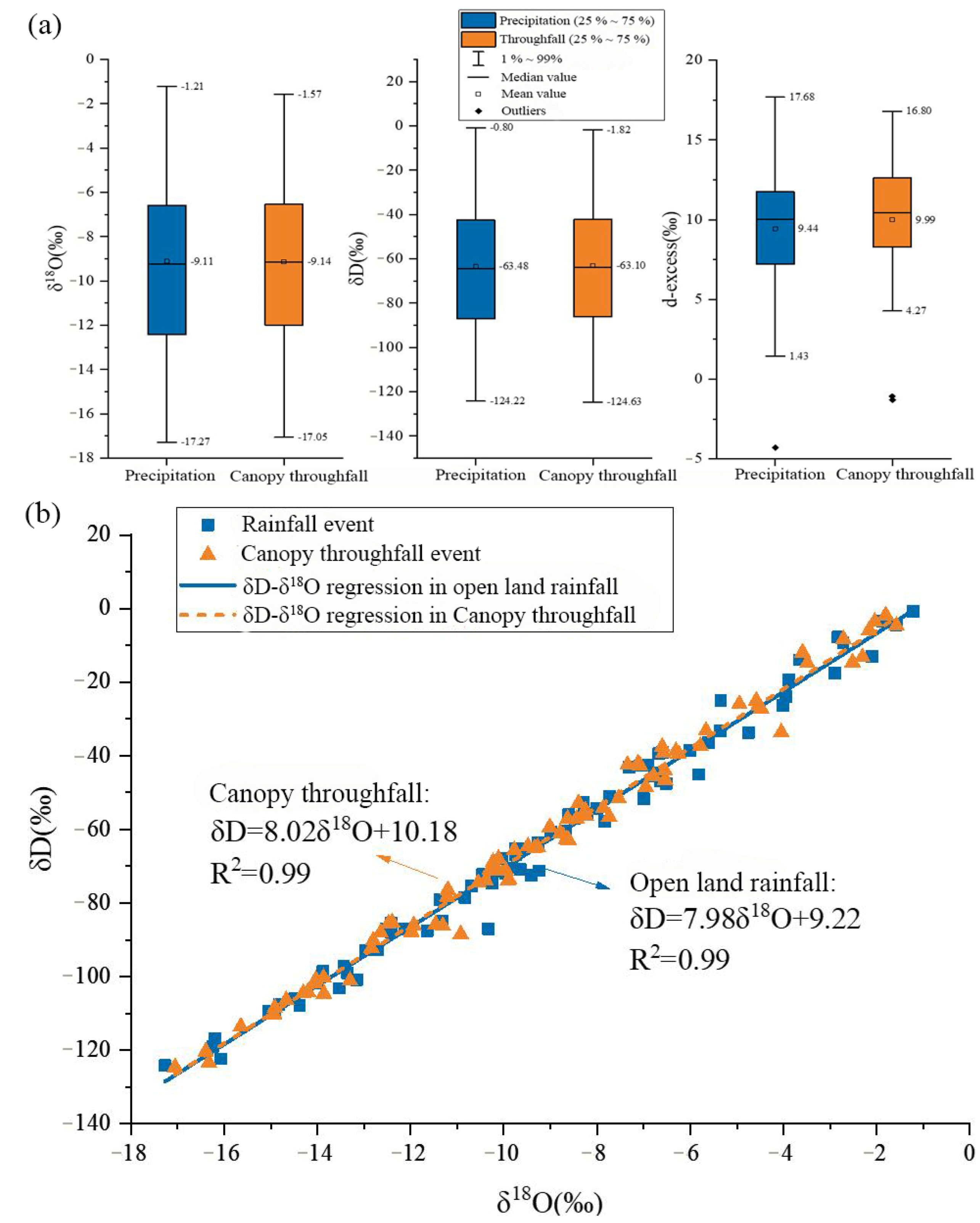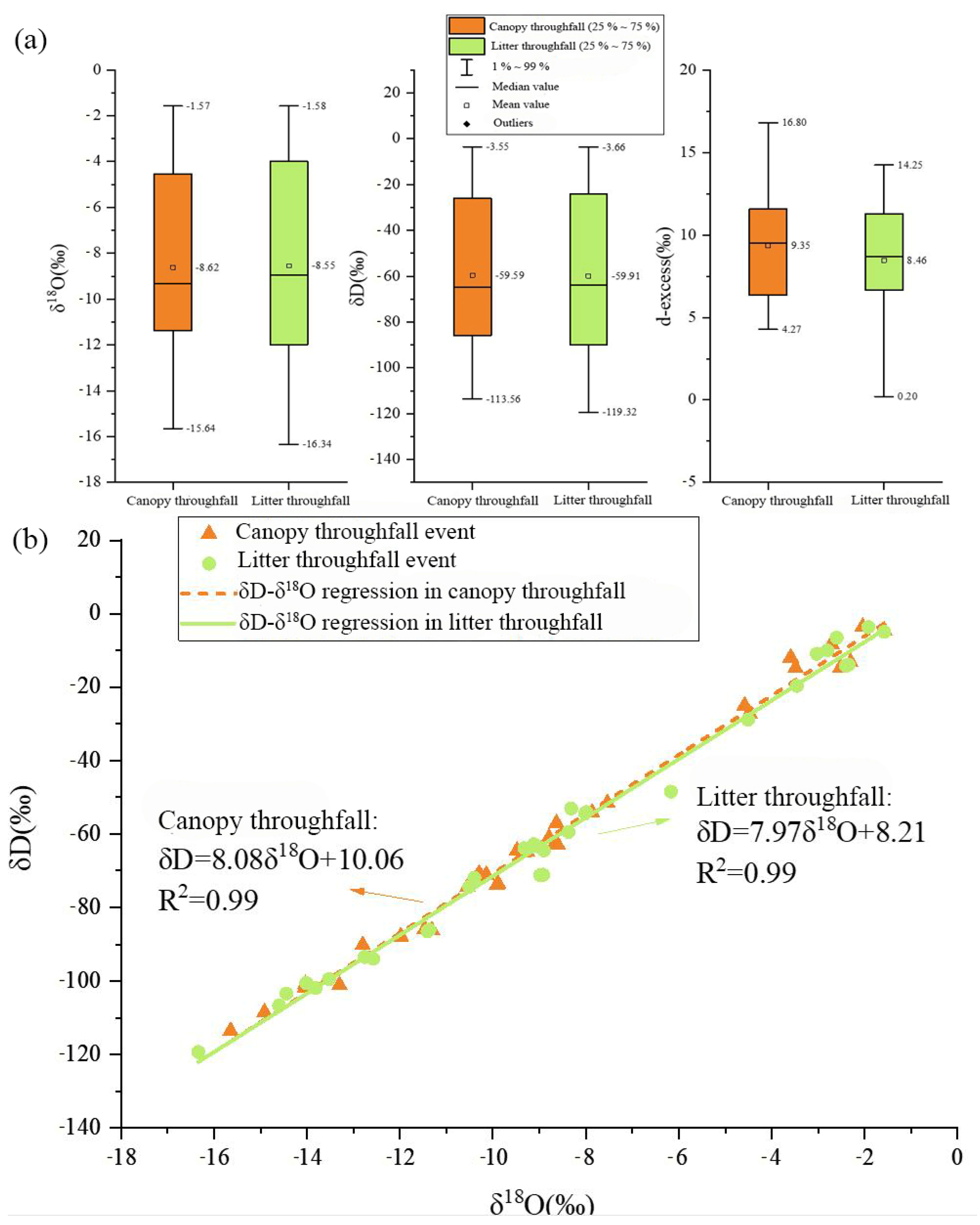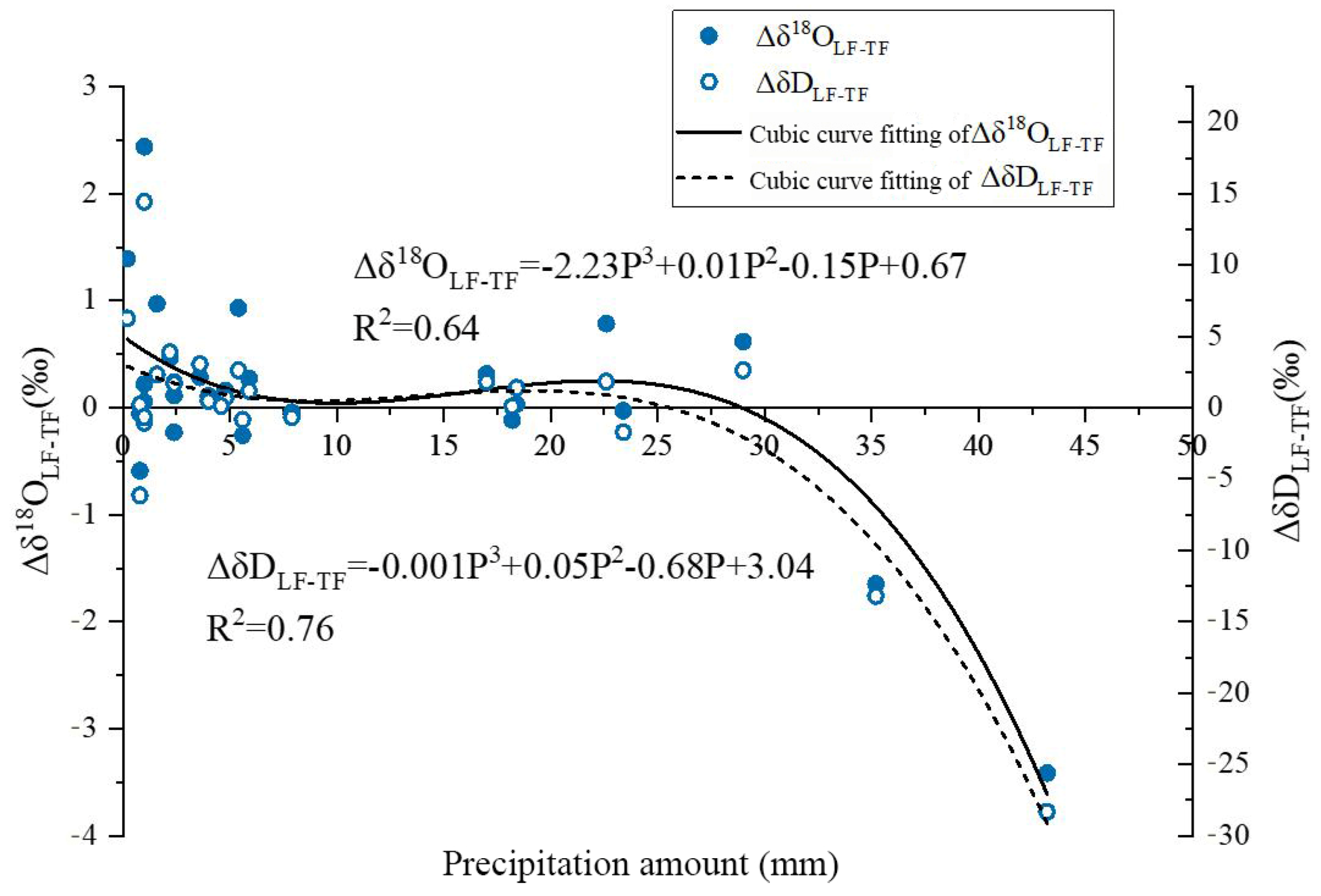Stable Isotopes Reveal the Effect of Canopy and Litter Layer Interception on Water Recharge in a Subtropical Manmade Forest of Southwest China
Abstract
:1. Introduction
2. Materials and Methods
2.1. Study Area
2.2. Sampling Collection and Analysis
3. Results and Discussion
3.1. Effect of Canopy Interception Revealed by RF-TF Isotopic Comparison
3.2. Effect of Litter Layer Interception Revealed by TF-LF Isotopic Comparison
3.3. Relationship between Interception Effect and Characteristics of Precipitation
4. Conclusions
Author Contributions
Funding
Data Availability Statement
Conflicts of Interest
References
- Held, I.M.; Soden, B.J. Robust responses of the hydrological cycle to global warming. J. Clim. 2006, 19, 5686–5699. [Google Scholar] [CrossRef]
- Hu, K.X.; Awange, J.L.; Kuhn, M.; Saleem, A. Spatio-temporal groundwater variations associated with climatic and anthropogenic impacts in South-West Western Australia. Sci. Total Environ. 2019, 696, 133599. [Google Scholar] [CrossRef] [PubMed]
- Bates, B.C.; Kundzewicz, Z.W.; Wu, S.; Palutikof, J.P. Climate Change and Water. In Technical Paper of the Intergovernmental Panel on Climate Change; IPCC: Geneva, Switzerland, 2008; ISBN 9789291691234. [Google Scholar]
- Ibrahim, M.F.M.; Faisal, A.; Shehata, S. Calcium Chloride Alleviates Water Stress in Sunflower Plants Through Modifying Some Physio-Biochemical Parameters. J. Agric. Environ. Sci. 2016, 16, 677–693. [Google Scholar]
- Ibrahim, M.F.M.; Ibrahim, H.A.; Abd El-Gawad, H.G. Folic acid as a protective agent in snap bean plants under water deficit conditions. J. Hortic. Sci. Biotechnol. 2021, 96, 94–109. [Google Scholar] [CrossRef]
- Rajmohan, N.; Masoud, M.H.Z.; Niyazi, B.A.M. Impact of evaporation on groundwater salinity in the arid coastal aquifer, Western Saudi Arabia. Catena 2021, 196, 104864. [Google Scholar] [CrossRef]
- Shi-Rong, L.; Peng-Sen, S.; Yuan-Guang, W. Comparative Analysis of Hydrological Functions of Major Forest Ecosystems in China. Chin. J. Plant Ecol. 2003, 27, 16–22. [Google Scholar] [CrossRef] [Green Version]
- Lin, M.; Sadeghi, S.M.M.; Van Stan, J.T. Partitioning of rainfall and sprinkler-irrigation by crop canopies: A global review and evaluation of available research. Hydrology 2020, 7, 76. [Google Scholar] [CrossRef]
- Sadeghi, S.M.M.; Gordon, D.A.; Van Stan, J.T. A global synthesis of throughfall and stemflow hydrometeorology. In Precipitation Partitioning by Vegetation: A Global Synthesis; Springer: Berlin/Heidelberg, Germany, 2020; pp. 48–69. ISBN 9783030297022. [Google Scholar]
- Dunkerley, D. A review of the effects of throughfall and stemflow on soil properties and soil erosion. In Precipitation Partitioning by Vegetation: A Global Synthesis; Springer: Berlin/Heidelberg, Germany, 2020; pp. 182–213. ISBN 9783030297022. [Google Scholar]
- Xiao, Q.; McPherson, E.G.; Ustin, S.L.; Grismer, M.E.; Simpson, J.R. Winter rainfall interception by two mature open-grown trees in Davis, California. Hydrol. Process. 2000, 14, 763–784. [Google Scholar] [CrossRef]
- Nearing, M.A. Soil Erosion and Conservation. In Environmental Modelling: Finding Simplicity in Complexity, 2nd ed.; John Wiley & Sons: Hoboken, NJ, USA, 2013; pp. 365–378. ISBN 9780470749111. [Google Scholar]
- Allen, S.T.; Keim, R.F.; Barnard, H.R.; McDonnell, J.J.; Renée Brooks, J. The role of stable isotopes in understanding rainfall interception processes: A review. WIREs Water 2017, 4, e1187. [Google Scholar] [CrossRef]
- Li, X.; Niu, J.; Xie, B. Study on hydrological functions of litter layers in North China. PLoS ONE 2013, 8, 70328. [Google Scholar] [CrossRef]
- Zavala, L.M.; Jordán, A.; Gil, J.; Bellinfante, N.; Pain, C. Intact ash and charred litter reduces susceptibility to rain splash erosion post-wildfire. Earth Surf. Process. Landf. 2009, 34, 1522–1532. [Google Scholar] [CrossRef]
- Wang, M.C.; Liu, C.P.; Sheu, B.H. Characterization of organic matter in rainfall, throughfall, stemflow, and streamwater from three subtropical forest ecosystems. J. Hydrol. 2004, 289, 275–285. [Google Scholar] [CrossRef]
- Savenije, H.H.G. The importance of interception and why we should delete the term evapotranspiration from our vocabulary. Hydrol. Process. 2004, 18, 1507–1511. [Google Scholar] [CrossRef]
- Barbieri, M. Isotopes in Hydrology and Hydrogeology. Water 2019, 11, 291. [Google Scholar] [CrossRef] [Green Version]
- Krishan, G.; Rao, M.S.; Vashisht, R.; Chaudhary, A.; Singh, J.; Kumar, A. Isotopic Assessment of Groundwater Salinity: A Case Study of the Southwest (SW) Region of Punjab, India. Water 2022, 14, 133. [Google Scholar] [CrossRef]
- Eissa, M.; Ali, M.; Zaghlool, E.; Stash, O.S. Hydrochemical and stable isotopes indicators for detecting sources of groundwater contamination close to Bahr El-Baqar drain, eastern Nile Delta, Egypt. Water Sci. 2019, 33, 54–64. [Google Scholar] [CrossRef] [Green Version]
- Eissa, M.; Shawky, H.; Samy, A.; Khalil, M.; El Malky, M. Geochemical and Isotopic Evidence of Groundwater Salinization Processes in El Dabaa Area, Northwestern Coast, Egypt. Geosciences 2018, 8, 392. [Google Scholar] [CrossRef] [Green Version]
- Laonamsai, J.; Ichiyanagi, K.; Patsinghasanee, S.; Kamdee, K.; Tomun, N. Application of Stable Isotopic Compositions of Rainfall Runoff for Evaporation Estimation in Thailand Mekong River Basin. Water 2022, 14, 2803. [Google Scholar] [CrossRef]
- Krishan, G.; Kumar, B.; Sudarsan, N.; Rao, M.S.; Ghosh, N.C.; Taloor, A.K.; Bhattacharya, P.; Singh, S.; Kumar, C.P.; Sharma, A.; et al. Isotopes (δ18O, δD and 3H) variations in groundwater with emphasis on salinization in the state of Punjab, India. Sci. Total Environ. 2021, 789, 148051. [Google Scholar] [CrossRef]
- Zhang, Y.; Xu, M.; Li, X.; Qi, J.; Zhang, Q.; Guo, J.; Yu, L.; Zhao, R. Hydrochemical Characteristics and Multivariate Statistical Analysis of Natural Water System: A Case Study in Kangding County, Southwestern China. Water 2018, 10, 80. [Google Scholar] [CrossRef] [Green Version]
- Botsyun, S.; Sepulchre, P.; Risi, C.; Donnadieu, Y. Impacts of Tibetan Plateau uplift on atmospheric dynamics and associated precipitation δ18O. Clim. Past 2016, 12, 1401–1420. [Google Scholar] [CrossRef]
- Botsyun, S.; Ehlers, T.A.; Mutz, S.G.; Methner, K.; Krsnik, E.; Mulch, A. Opportunities and Challenges for Paleoaltimetry in “Small” Orogens: Insights From the European Alps. Geophys. Res. Lett. 2020, 47, e2019GL086046. [Google Scholar] [CrossRef] [Green Version]
- Laonamsai, J.; Ichiyanagi, K.; Patsinghasanee, S. Isotopic temporal and spatial variations of tropical rivers in Thailand reflect monsoon precipitation signals. Hydrol. Process. 2021, 35, e14068. [Google Scholar] [CrossRef]
- Laonamsai, J.; Ichiyanagi, K.; Kamdee, K.; Putthividhya, A.; Tanoue, M. Spatial and temporal distributions of stable isotopes in precipitation over Thailand. Hydrol. Process. 2021, 35, e13995. [Google Scholar] [CrossRef]
- Heydarizad, M.; Minaei, M.; Ichiyanagi, K.; Sorí, R. The effects of local and regional parameters on the δ18O and δ2H values of precipitation and surface water resources in the Middle East. J. Hydrol. 2021, 600, 126485. [Google Scholar] [CrossRef]
- Xia, C.; Liu, G.; Chen, K.; Hu, Y.; Zhou, J.; Liu, Y.; Mei, J. Stable Isotope Characteristics for Precipitation Events and Their Responses to Moisture and Environmental Changes During the Summer Monsoon Period in Southwestern China. Polish J. Environ. Stud. 2020, 29, 2429–2445. [Google Scholar] [CrossRef]
- Heydarizad, M.; Gimeno, L.; Sorí, R.; Minaei, F.; Mayvan, J.E. The Stable Isotope Characteristics of Precipitation in the Middle East Highlighting the Link between the Köppen Climate Classifications and the δ18O and δ2H Values of Precipitation. Water 2021, 13, 2397. [Google Scholar] [CrossRef]
- Xu, X.; Guan, H.; Deng, Z. Isotopic composition of throughfall in pine plantation and native eucalyptus forest in South Australia. J. Hydrol. 2014, 514, 150–157. [Google Scholar] [CrossRef]
- Allen, S.T.; Keim, R.F.; McDonnell, J.J. Spatial patterns of throughfall isotopic composition at the event and seasonal timescales. J. Hydrol. 2015, 522, 58–66. [Google Scholar] [CrossRef]
- Goldsmith, G.R.; Allen, S.T.; Braun, S.; Engbersen, N.; González-Quijano, C.R.; Kirchner, J.W.; Siegwolf, R.T.W. Spatial variation in throughfall, soil, and plant water isotopes in a temperate forest. Ecohydrology 2019, 12, 2059. [Google Scholar] [CrossRef]
- Lee, J.E.; Fung, I. “Amount effect” of water isotopes and quantitative analysis of post-condensation processes. Hydrol. Process. 2008, 22, 1–8. [Google Scholar] [CrossRef]




| Sampling Date | Event Number | TF-RF Isotopic Difference (‰) | LF-TF Isotopic Difference (‰) | Precipitation Amount (mm) | Precipitation Intensity (mm/h) | ||||
|---|---|---|---|---|---|---|---|---|---|
| ΔD | Δδ18O | Δd-Excess | ΔD | Δδ18O | Δd-Excess | ||||
| 2019/7/3 | 2 | −1.02 | −0.60 | 3.76 | - | - | - | 2.7 | 2.31 |
| 2019/7/3 | 3 | 1.97 | 0.67 | −3.38 | - | - | - | 2.6 | 1.28 |
| 2019/7/4 | 1 | −0.92 | 0.40 | −4.08 | - | - | - | 15.4 | 1.60 |
| 2019/7/6 | 1 | 0.11 | 0.71 | −5.55 | - | - | - | 0.5 | 0.50 |
| 2019/7/7 | 2 | 1.47 | −0.01 | 1.55 | - | - | - | 13.8 | 2.24 |
| 2019/7/9 | 1 | 0.75 | 0.37 | −2.20 | - | - | - | 31.4 | 5.32 |
| 2019/7/10 | 1 | 0.18 | −0.30 | 2.59 | - | - | - | 2.4 | 1.11 |
| 2019/7/11 | 1 | 0.59 | −0.05 | 0.97 | - | - | - | 62.2 | 8.20 |
| 2019/7/11 | 2 | 0.68 | −0.04 | 0.97 | - | - | - | 8.5 | 3.21 |
| 2019/7/14 | 1 | −0.96 | −0.44 | 2.54 | - | - | - | - | - |
| 2019/7/15 | 1 | 0.54 | 0.21 | −1.15 | - | - | - | - | - |
| 2019/7/16 | 1 | 1.29 | 0.36 | −1.61 | - | - | - | - | - |
| 2019/7/21 | 1 | 1.35 | 0.10 | 0.56 | - | - | - | 2.9 | 0.97 |
| 2019/7/22 | 1 | −2.31 | −0.28 | −0.09 | - | - | - | 41.5 | 7.18 |
| 2020/7/16 | 1 | 0.98 | 0.19 | −0.51 | - | - | - | 36.8 | 3.07 |
| 2020/7/17 | 1 | 0.60 | 0.13 | −0.45 | - | - | - | 2.6 | 0.95 |
| 2020/7/18 | 1 | 2.14 | −0.37 | 5.07 | - | - | - | 2.8 | 3.73 |
| 2020/7/21 | 1 | −1.04 | −0.15 | 0.18 | - | - | - | 5.0 | 2.00 |
| 2020/7/22 | 1 | 3.42 | 0.29 | 1.10 | - | - | - | 2.6 | 0.61 |
| 2020/7/29 | 1 | −0.28 | −0.10 | 0.52 | - | - | - | - | - |
| 2020/7/29 | 2 | 0.17 | −0.02 | 0.32 | - | - | - | - | - |
| 2020/7/29 | 3 | −0.83 | −0.24 | 1.07 | - | - | - | 2.6 | 1.30 |
| 2020/7/30 | 1 | −0.13 | −0.17 | 1.24 | - | - | - | 10.7 | - |
| 2020/7/31 | 1 | 0.16 | −0.08 | 0.79 | - | - | - | 3.8 | - |
| 2020/7/31 | 2 | 3.38 | 0.23 | 1.57 | - | - | - | 0.2 | 0.30 |
| 2020/8/1 | 1 | 1.31 | −0.02 | 1.50 | - | - | - | - | - |
| 2020/8/2 | 1 | −0.64 | −0.03 | −0.43 | - | - | - | 1.8 | 0.32 |
| 2020/8/3 | 1 | −0.30 | −0.02 | −0.18 | - | - | - | 2.0 | 4.00 |
| 2020/8/4 | 1 | 0.95 | 0.15 | −0.27 | - | - | - | 6.6 | 1.69 |
| 2020/8/7 | 1 | 1.53 | 0.05 | 1.09 | - | - | - | - | - |
| 2020/8/7 | 2 | −0.14 | −0.22 | 1.61 | - | - | - | 0.4 | 0.15 |
| 2020/8/11 | 1 | 0.19 | 0.02 | 0.06 | - | - | - | 20.4 | 3.40 |
| 2020/8/11 | 2 | −1.70 | 0.01 | −1.82 | - | - | - | 12.8 | 2.74 |
| 2020/8/11 | 3 | −2.92 | −0.31 | −0.40 | - | - | - | 43.8 | 3.13 |
| 2020/8/12 | 1 | 1.92 | 0.29 | −0.36 | - | - | - | 4.8 | 1.20 |
| 2020/8/13 | 1 | −1.00 | −0.26 | 1.08 | - | - | - | 1.8 | 1.44 |
| 2020/8/13 | 2 | −1.41 | −0.33 | 1.22 | - | - | - | 2.5 | - |
| 2020/8/14 | 1 | −0.41 | 0.22 | −2.14 | - | - | - | 63.0 | 7.27 |
| 2020/8/16 | 1 | −1.37 | −0.15 | −0.16 | - | - | - | 115.4 | 7.54 |
| 2020/8/16 | 2 | −2.41 | −0.55 | 1.97 | - | - | - | 0.4 | 0.53 |
| 2020/8/16 | 3 | 1.17 | 0.15 | −0.02 | - | - | - | 78.2 | 7.11 |
| 2020/8/23 | 1 | −1.49 | −0.59 | 3.21 | - | - | - | - | - |
| 2020/8/28 | 1 | 0.40 | 0.10 | −0.43 | - | - | - | 9.6 | 12.80 |
| 2020/8/29 | 1 | −1.54 | −0.72 | 4.19 | - | - | - | 2.8 | 1.40 |
| 2020/8/30 | 2 | −0.91 | −0.17 | 0.48 | - | - | - | 0.4 | 0.34 |
| 2020/8/31 | 1 | −0.01 | 0.01 | −0.09 | - | - | - | 36.4 | 3.64 |
| 2021/7/2 | 1 | −0.71 | −0.46 | 2.98 | −1.71 | −0.03 | −1.49 | 23.4 | 9.96 |
| 2021/7/8 | 1 | −1.64 | −0.42 | 1.71 | 0.46 | 0.11 | −0.43 | 4.0 | 1.33 |
| 2021/7/9 | 1 | −0.66 | −0.13 | 0.35 | −1.79 | −0.33 | 0.81 | - | - |
| 2021/7/10 | 1 | −2.69 | −0.67 | 2.67 | 2.62 | 0.93 | −4.83 | 5.4 | 0.68 |
| 2021/7/11 | 1 | −0.97 | −0.49 | 2.91 | 2.34 | 0.97 | −5.45 | 1.6 | 0.21 |
| 2021/7/15 | 1 | 5.33 | 0.49 | 1.44 | −28.32 | −3.41 | −1.01 | 43.2 | 2.50 |
| 2021/7/16 | 1 | 5.00 | 0.73 | −0.84 | −6.14 | −0.59 | −1.43 | 0.8 | 2.18 |
| 2021/7/18 | 1 | 8.41 | 0.98 | 0.53 | 3.05 | 0.28 | 0.77 | 3.6 | 0.38 |
| 2021/7/19 | 1 | −11.20 | −1.60 | 1.64 | 14.44 | 2.44 | −5.08 | 1.0 | 3.16 |
| 2021/7/21 | 1 | 0.26 | 0.14 | −0.88 | 0.10 | −0.12 | 1.03 | 18.2 | 2.21 |
| 2021/7/24 | 1 | 0.03 | −0.15 | 1.26 | 2.63 | 0.62 | −2.31 | 29.0 | 6.06 |
| 2021/7/26 | 1 | −0.53 | 0.20 | −2.16 | −1.49 | −0.78 | 4.77 | - | - |
| 2021/8/5 | 1 | 2.05 | 0.06 | 1.59 | 1.84 | 0.79 | −4.45 | 22.6 | 2.83 |
| 2021/8/8 | 1 | 0.89 | 0.00 | 0.87 | 1.79 | 0.11 | 0.87 | 2.4 | 2.40 |
| 2021/8/10 | 1 | −1.01 | −0.64 | 4.11 | 5.34 | 1.12 | −3.64 | - | - |
| 2021/8/11 | 1 | 4.40 | 0.60 | −0.40 | −0.66 | −0.04 | −0.33 | 7.9 | 5.27 |
| 2021/8/12 | 1 | −0.23 | 0.00 | −0.23 | −0.28 | 0.00 | −0.26 | - | - |
| 2021/8/12 | 2 | −0.15 | −0.18 | 1.27 | −0.11 | 0.12 | −1.06 | - | - |
| 2021/8/12 | 3 | 4.58 | 0.40 | 1.37 | 3.89 | 0.46 | 0.20 | 2.2 | 0.80 |
| 2021/8/13 | 1 | 2.03 | 0.47 | −1.75 | 1.18 | 0.27 | −1.01 | 5.9 | 2.95 |
| 2021/8/15 | 1 | 0.83 | −0.18 | 2.26 | −0.83 | −0.26 | 1.21 | 5.6 | 2.24 |
| 2021/8/15 | 2 | 0.77 | 0.13 | −0.23 | 0.69 | 0.16 | −0.59 | 4.8 | 0.45 |
| 2021/8/17 | 1 | 0.85 | 0.14 | −0.27 | 0.13 | 0.04 | −0.18 | 4.6 | 0.84 |
| 2021/8/17 | 2 | −7.14 | −1.04 | 1.17 | 6.28 | 1.39 | −4.87 | 0.2 | - |
| 2021/8/17 | 3 | −4.17 | −0.59 | 0.57 | −5.76 | −0.69 | −0.22 | - | - |
| 2021/8/18 | 1 | −2.93 | −0.70 | 2.65 | 1.40 | 0.03 | 1.13 | 18.4 | 2.94 |
| 2021/8/19 | 1 | 16.00 | 2.16 | −1.32 | −1.06 | 0.22 | −2.81 | 1.0 | 3.53 |
| 2021/8/19 | 2 | −0.26 | −0.14 | 0.89 | 1.67 | −0.23 | 3.50 | 2.4 | 1.62 |
| 2021/8/21 | 1 | 1.32 | 0.33 | −1.33 | 0.21 | −0.05 | 0.65 | 0.8 | 1.45 |
| 2021/8/22 | 1 | −0.73 | −0.14 | 0.43 | −0.65 | 0.06 | −1.11 | 1.0 | 1.94 |
| 2021/8/22 | 2 | 1.42 | 0.00 | 1.45 | 1.80 | 0.32 | −0.73 | 17.0 | 1.77 |
| 2021/8/25 | 1 | 7.11 | 0.63 | 2.05 | −13.20 | −1.65 | −0.03 | 35.2 | 2.27 |
Disclaimer/Publisher’s Note: The statements, opinions and data contained in all publications are solely those of the individual author(s) and contributor(s) and not of MDPI and/or the editor(s). MDPI and/or the editor(s) disclaim responsibility for any injury to people or property resulting from any ideas, methods, instructions or products referred to in the content. |
© 2023 by the authors. Licensee MDPI, Basel, Switzerland. This article is an open access article distributed under the terms and conditions of the Creative Commons Attribution (CC BY) license (https://creativecommons.org/licenses/by/4.0/).
Share and Cite
Xia, C.; Liu, G.; Luo, J. Stable Isotopes Reveal the Effect of Canopy and Litter Layer Interception on Water Recharge in a Subtropical Manmade Forest of Southwest China. Forests 2023, 14, 129. https://doi.org/10.3390/f14010129
Xia C, Liu G, Luo J. Stable Isotopes Reveal the Effect of Canopy and Litter Layer Interception on Water Recharge in a Subtropical Manmade Forest of Southwest China. Forests. 2023; 14(1):129. https://doi.org/10.3390/f14010129
Chicago/Turabian StyleXia, Chengcheng, Guodong Liu, and Jian Luo. 2023. "Stable Isotopes Reveal the Effect of Canopy and Litter Layer Interception on Water Recharge in a Subtropical Manmade Forest of Southwest China" Forests 14, no. 1: 129. https://doi.org/10.3390/f14010129





